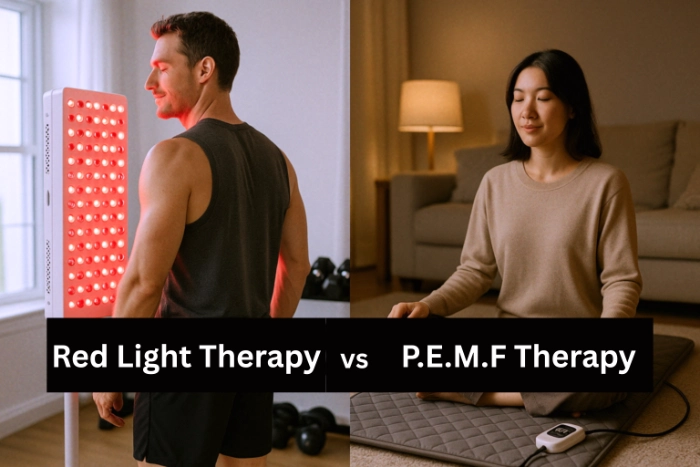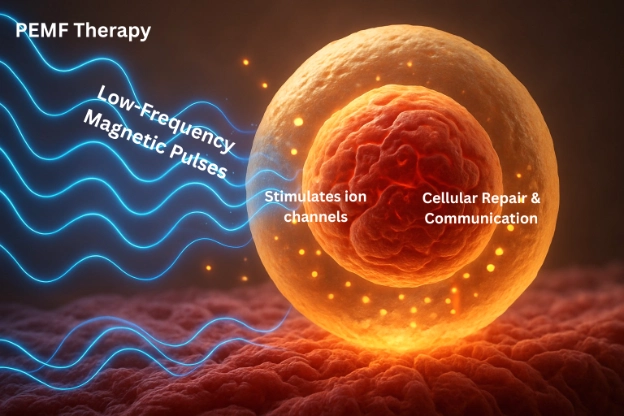PEMF vs Red Light Therapy: Which One Works Best?

When you’re looking into tools that promise better recovery, less pain, and maybe even a boost in long-term health, two names keep coming up over and over: PEMF vs Red Light Therapy. At first glance, they sound like they’re solving the same problem. Some kind of wellness tech that makes your body heal and eventually “feel better”. But dig a little deeper, and you’ll see they’re actually working in very different ways.
Here’s the real question most people have: which one is actually worth your time and money? That’s what we’re going to unpack. By the end, you’ll not only know how each works, but also where each shines, where they fall short, …and whether using them together even makes sense.
What Is PEMF Therapy and How Does It Work?
PEMF stands for Pulsed Electromagnetic Field therapy. The idea is simple: it uses gentle electromagnetic pulses to nudge your body’s cells back into a healthier rhythm and state. Some people describe the sensation as “charging your cells,”... like your body is getting plugged back into its own power source.
On a biological level, PEMF briefly changes the charge of your cell membranes. That little change then opens up ion channels, especially for calcium. All of this kickstarts repair processes and improves blood circulation. The end result is that your body gets signaled into healing mode.
What people notice in practice often lines up with the science. There are countless stories of back pain, joint stiffness… or even nagging injuries. All with pain and symptoms easing up after consistent sessions. Many also talk about better sleep and more energy throughout the day. It’s not uncommon to hear someone say, “After a treatment, I feel like my body just craves that wellness feeling now.”
But it’s not all upside. PEMF comes with its own challenges. The bigger, clinical devices can be extremely expensive. Even at-home mats aren’t “cheap”. The therapy often requires consistency. In some severe use cases, sometimes even hours each day for weeks… just to get the full effect. And it’s not suitable for everyone. If you have a pacemaker or are pregnant, it’s a clear no. PEMF Therapy side effects are rare but they do exist.
Recent research has added even more weight behind PEMF’s use. In a 2025 randomized controlled trial on Evaluating Noninvasive Pulsed Electromagnetic Field Therapy for Joint and Soft Tissue Pain, patients saw a 36% reduction in pain scores compared to just 10% in standard treatment. Even more impressive, medication use dropped by over half in the PEMF group. That’s not placebo. That’s a measurable and statistically significant clinical effect.
If you’re curious about the bigger picture of its effectiveness beyond just pain studies, Does PEMF Therapy Really Work goes into the science of some practical experiences in depth.
What Is Red Light Therapy and How Does It Work?
Red light therapy takes a different path. Instead of electromagnetic fields, it uses visible red and near-infrared light to fuel your cells… directly! (PEMF is indirect). The light is absorbed by a protein in your mitochondria (your energy factories), which boosts ATP. This is the energy currency your body runs on. Think of it like giving your cells more fuel to work with.
People often notice the effects most obviously on their skin. Smoother texture, fewer wrinkles, less acne…those are some of the headline results. But the benefits go beyond just looks. Red light can help reduce inflammation, speed up muscle recovery, and support circulation. For some, it’s also been a surprising tool for pain relief.
However, red light therapy isn’t a quick fix. Some people use it daily for weeks before they notice significant changes. The quality of your device quality also matters. Low cost panels sometimes use the wrong wavelengths, which then means you can unknowingly waste time without getting the intended effects. And while Red Light Therapy is generally safe, overuse can leave your skin feeling very sensitive or your eyes strained if you don’t protect them.
The science here is robust. An umbrella review published in 2025, Effects of Photobiomodulation on Multiple Health Outcomes, pulled together data from over 200 randomized controlled trials. It showed moderate certainty evidence that red light therapy helps with several conditions. From knee osteoarthritis to fibromyalgia fatigue, and even improved cognitive function in some cases. All of this is no longer fringe science. This is now a broad base of clinical data pointing in the same direction.
If you’re interested in specific applications, especially for appearance, How to Use Red Light Therapy on Face covers the practical side of incorporating it into a daily routine.
PEMF vs Red Light Therapy: Key Differences and Benefits
So how do they stack up when you put them side by side?
PEMF works deep! Think bones, joints, and long-standing pain conditions. Red light works more at the surface and mid level layers. This makes it powerful for skin, muscle recovery, and some localized inflammation.
Here’s what that comparison looks like in plain terms:
PEMF is the better option when you’re dealing with deep tissue issues, chronic pain… and even some use cases involving bone healing. Sessions can last anywhere from 20 minutes to several hours depending on the device. The effects are often described as “systemic” You feel it throughout your body.
Red Light Therapy shines when the goal is visible skin improvements, reducing soreness after workouts,... or supporting anti aging routines. Sessions are shorter, usually 10-20 minutes per area. The results show up more gradually over weeks to months.
A 2025 meta-analysis, The Effectiveness of Pulsed Electromagnetic Field Therapy in Patients with Shoulder Impingement Syndrome, found PEMF provided not just short-term pain reduction but long-term functional improvements as well. The benefits actually lasted. On the flip side, red light therapy’s clinical reviews consistently highlight outcomes like improved collagen production (with one study showing a 38% increase in just 12 weeks).
That makes the decision less about which one is universally “better” and more about which one fits YOUR personal goals. If deep recovery and pain relief are your priority, PEMF has the edge. If skin, surface level healing, and general recovery are what you’re after, red light therapy is a better match.
To understand how PEMF compares to another popular wellness trend, PEMF Mat vs Grounding Mat explores the differences in how they interact with the body.
Can You Do PEMF and Red Light Therapy Together?
This is one of the most common questions, and the answer is yes! You absolutely can, and many people find they get the best results this way.
Here’s why: red light gives your cells extra energy, while PEMF improves how efficiently your body uses that energy by enhancing cellular communication and circulation. One fuels, the other delivers.
People who combine the two often describe feeling not just quicker recovery, but they also feel more energized and balanced overall. Clinical studies (and user experiences) both point toward synergy, not conflict.
And yes, there are combination devices on the market now that deliver both therapies at once. While they can be an investment, the feedback is usually very positive: “Together, they enhance healing, decrease inflammation, and speed up recovery.”
Since safety is always a big consideration, Are PEMF Mats Safe breaks down what to know about device quality, certification, and when you need to be more careful.
Conclusion: PEMF vs Red Light Therapy
Both PEMF and red light therapy work. But they work differently. PEMF reaches deep. It tackles pain, bone health, and long-term recovery. Red light focuses more on the surface. It offers benefits for skin, general inflammation, and shorter recovery cycles.
Neither is a magic bullet or quick fix. They take consistency. They take using the right kind of device, and they also need you to set realistic expectations. But when used regularly (especially in combination), they can play a real role in improving quality of life. The most satisfied people aren’t the ones chasing overnight results. They’re the ones who give these therapies weeks or months and treat them as part of a long term investment in their health.
Frequently Asked Questions
Is PEMF the same as red light therapy?
No. PEMF uses electromagnetic fields to stimulate deep tissue repair, while red light uses visible and near-infrared light to fuel energy production in cells closer to the surface.
What is better than red light therapy?
That depends on the goal. For deep pain, bone healing, and systemic recovery, PEMF often delivers more impactful results. For skin, surface healing, and anti-aging, red light is unmatched.
Can you do PEMF and red light therapy together?
Yes, and many people find that the combination works better than either therapy alone. They complement each other at different levels in the body.
Are there any risks with PEMF or red light therapy?
Both are considered safe when used properly. PEMF should not be used with pacemakers or during pregnancy. Red light therapy may cause mild eye strain or skin sensitivity if overused.
Keep Exploring:
Your recovery toolbox is bigger than you think. Ready to see what else makes the cut?
Infrared saunas can feel amazing for recovery and relaxation, but are there hidden risks you should know about? Learn what really matters before your next sweat session.
They’re everywhere in gyms and recovery routines. But do massage guns actually ease soreness, or are they just mask it for a while? The answer might not be what you expect.
Infrared heating pads claim to go deeper than traditional heat therapy with penetrating warmth that reaches past the surface. Could an infrared heating pad unlock deeper recovery than old-school heat packs? Here’s what to know.
This article is for informational purposes only and is not intended to provide medical advice. Always consult your qualified healthcare professional before beginning any new health, wellness or recovery regimen.



